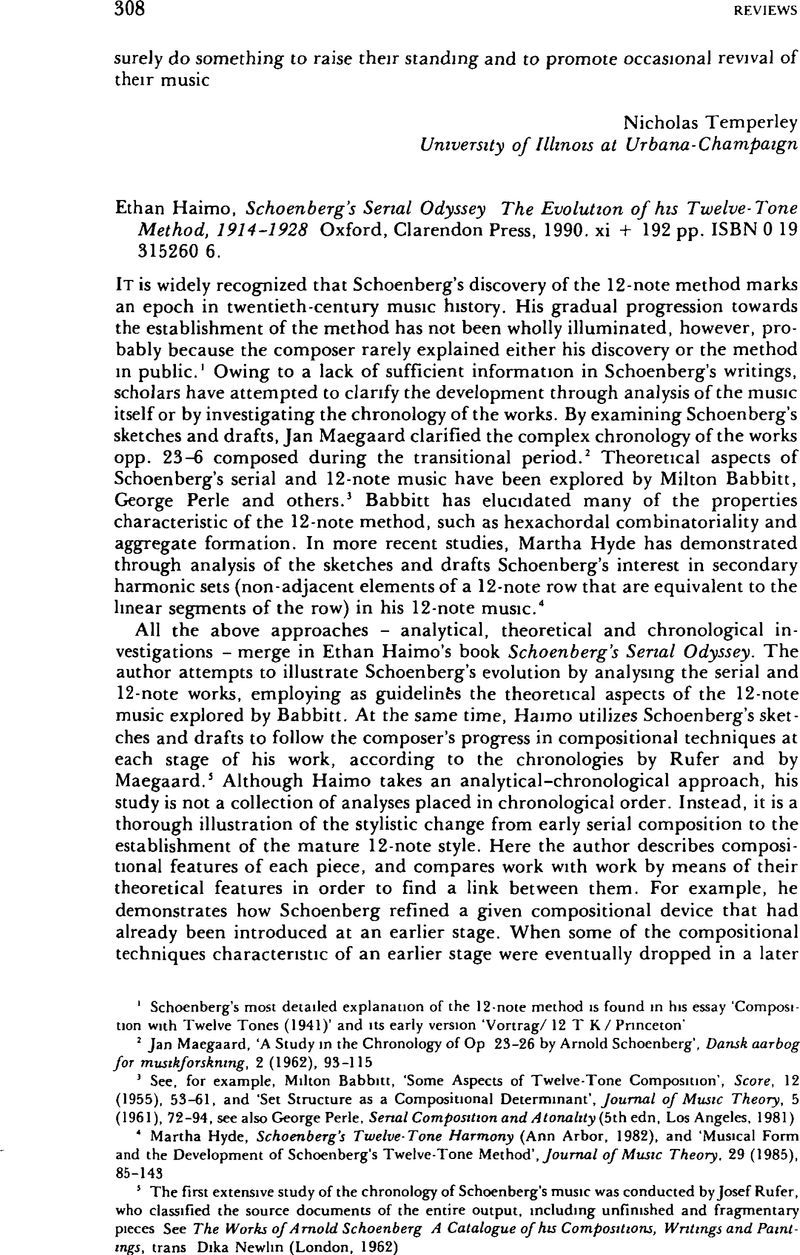No CrossRef data available.
Published online by Cambridge University Press: 01 January 2020

1 Schoenberg's most detailed explanation of the 12-note method is found in his essay ‘Composition with Twelve Tones (1941)’ and its early version ‘Vortrag/ 12 T K/ Princeton’Google Scholar
2 Maegaard, Jan, ‘A Study in the Chronology of Op 23–26 by Arnold Schoenberg’, Dansh aarbog for musikforskning, 2 (1962), 93–115Google Scholar
3 See, for example, Milton Babbitt, ‘Some Aspects of Twelve-Tone Composition’, Score, 12 (1955), 53–61, and ‘Set Structure as a Compositional Determinant’, Journal of Music Theory, 5 (1961), 72–94, see also George Perle, Sertal Composition and Atonality (5th edn, Los Angeles, 1981)Google Scholar
4 Hyde, Martha, Schoenberg's Twelve-Tone Harmony (Ann Arbor, 1982), and ‘Musical Form and the Development of Schoenberg's Twelve-Tone Method’, Journal of Music Theory, 29 (1985), 85–143Google Scholar
5 The first extensive study of the chronology of Schoenberg's music was conducted by Josef Rufer, who classified the source documents of the entire output, including unfinished and fragmentary pieces See The Works of Arnold Schoenberg A Catalogue of his Compositions, Writings and Paintings, trans Dika Newlin (London, 1962)Google Scholar
6 For example, Josef Rufer regarded Schoenberg's non-12-note serial works, opp 23–4, as precursors of the 12-note music, as works that hold a key position in the development of the 12-note method (see Composition with Twelve Tones, trans Humphrey Searle, New York, 1954) Like Rufer, other scholars have also discussed the serial works as the starting-point of Schoenberg's evolutionGoogle Scholar
7 I examined the sketches and drafts for these unfinished works in my thesis ‘The Origin and Development of Schoenberg's Twelve-Tone Method’ (Ph D dissertation, Yale University, 1988), and in ‘On the Origin of the Twelve-Tone Method Schoenberg's Sketches for the Unfinished Symphony (1914–15)’, Current Musicology, 42 (1986), 32–45Google Scholar
8 Hyde has argued in her articles that Schoenberg systematically used this technique not only in the harmony, but also in several other dimensions Haimo's objection to Hyde's extension of the idea, found in his footnote on p 31, is based on two points First, Hyde concentrates only on the ‘associative harmony’ characteristic of Schoenberg's early 12-note works, and does not take into account the change that occurred in later years. Second, Hyde's theory of secondary harmonic sets (‘associative harmony’ in Haimo's terminology) cannot be applied to every surface of Schoenberg's 12-note music, his works always include the harmonies that are not equivalent to embedded harmonies of the basic 12-note rowGoogle Scholar
9 To be consistent with Haimo's notation, I will use curly brackets and commas to indicate interval vectors.Google Scholar
10 Any 12-note row is divided into two hexachords that are transpositionally or inversionally equivalent, or two Z-related hexachords (having identical vectors) For Z-related hexachords, see Forte, Allen, The Structure of Atonal Music (New Haven and London, 1973) 79Google Scholar